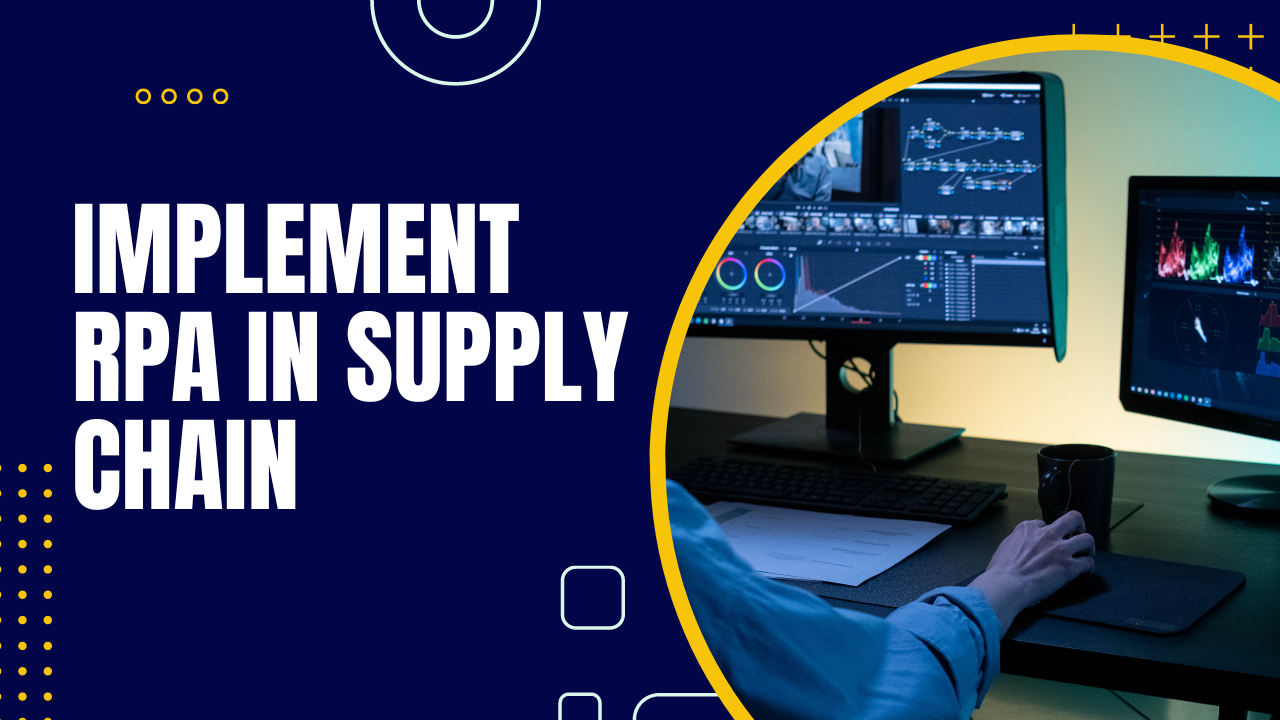Unlocking the Power of RPA in Supply Chain Management: Streamlining Your Processes

In today’s fast-paced business environment, organizations of all sizes are looking for ways to streamline their supply chain processes and increase efficiency. One solution that is gaining popularity is the use of Robotic Process Automation (RPA) services. RPA can help organizations automate manual and repetitive tasks, reduce operational costs, and minimize errors. In this article, we will explore the role of RPA in supply chain management and share practical tips on how to implement RPA successfully in your organization.
Understanding the Role of RPA in Supply Chain Management
RPA is an emerging technology that uses software robots, or “bots,” to automate repetitive and rule-based tasks. These bots can mimic user actions, such as logging into applications, copying and pasting data, and filling out forms. RPA can be applied in various business functions, including finance, human resources, and customer service. However, in this article, we will focus on the Role of RPA in Supply Chain Management.
Mobile application development plays a crucial role in revolutionizing Supply Chain Management (SCM) through the implementation of Robotic Process Automation (RPA). RPA enables the automation of repetitive tasks, data entry, and information exchange, leading to increased efficiency and accuracy in supply chain operations. By leveraging mobile applications, organizations can extend the power of RPA to the fingertips of supply chain professionals, empowering them with real-time access to critical information, process monitoring, and streamlined communication.
App developers play a crucial role in revolutionizing the field of Supply Chain Management (SCM) through Robotic Process Automation (RPA). These skilled professionals possess a deep understanding of both SCM principles and cutting-edge technologies, allowing them to create innovative applications tailored specifically for this industry. RPA in SCM involves automating repetitive tasks, streamlining workflows, and enhancing operational efficiency. App developers specializing in this area utilize their expertise to design and develop intuitive, user-friendly applications that seamlessly integrate with existing SCM systems. By leveraging RPA, these developers empower organizations to automate processes such as inventory management, order fulfillment, demand forecasting, and logistics coordination.
What is Robotic Process Automation (RPA)?
Robotic Process Automation (RPA) is an emerging technology that uses software robots, or “bots,” to automate repetitive and rule-based tasks. These bots can mimic user actions, such as logging into applications, copying and pasting data, and filling out forms. Robotic process automation companies can be applied in various business functions, including finance, human resources, and customer service. However, in this article, we will focus on the Role of RPA in Supply Chain Management.
Benefits of RPA in Supply Chain Management
The benefits of RPA in supply chain management are numerous. Firstly, RPA can help organizations reduce operational costs by automating manual and repetitive tasks that would otherwise have to be performed by humans. This frees up employees to focus on higher-value tasks, such as strategic planning and analysis. Additionally, RPA can help organizations improve accuracy and minimize errors by reducing the potential for human error. Finally, RPA can help organizations increase efficiency by automating tasks that would otherwise take a long time to perform manually.
Identifying Key Supply Chain Processes for RPA Implementation
Before implementing RPA in your supply chain processes, it is essential to identify which processes will benefit the most from automation. With the rise of technology, supply chain management has become more complex, and organizations are seeking ways to optimize their processes. Robotic Process Automation (RPA) is a technology that can help organizations automate their supply chain processes, reduce costs, and improve efficiency.
In this article, we will discuss some of the key supply chain processes that can benefit from RPA, including procurement and supplier management, inventory management and optimization, order processing and fulfillment, and logistics and transportation management.
Procurement and Supplier Management
Procurement and supplier management involves the process of acquiring goods and services from external suppliers. This process can be time-consuming and complex, especially when dealing with multiple suppliers. By implementing RPA in this process, organizations can automate the tasks of extracting data from supplier contracts, validating invoices, and processing payments. This can help reduce errors and improve accuracy while also allowing employees to focus on more strategic tasks such as supplier relationship management. With RPA, organizations can also ensure compliance with supplier contracts, reduce the risk of fraud, and improve supplier performance.
Inventory Management and Optimization
Inventory management and optimization involves the process of balancing inventory levels to meet customer demand while minimizing costs. This process can be challenging, especially when dealing with a large number of SKUs. By implementing RPA in this process, organizations can automate the tasks of tracking inventory levels, identifying stockouts, and generating purchase orders. This can help reduce costs and minimize the risk of stockouts while also freeing up employees to focus on more strategic tasks such as demand forecasting. With RPA, organizations can also optimize their inventory levels, reduce carrying costs, and improve their order fulfillment rates.
Order Processing and Fulfillment
Order processing and fulfillment involves the process of accepting and processing customer orders and fulfilling them. This process can be time-consuming and prone to errors, especially when dealing with a large number of orders. By implementing RPA in this process, organizations can automate the tasks of order confirmation, verification, and shipment tracking. This can help reduce cycle times and improve order accuracy while also freeing up employees to focus on more strategic tasks such as customer service. With RPA, organizations can also improve their order fulfillment rates, reduce shipping costs, and enhance their customer experience.
Logistics and Transportation Management
Logistics and transportation management involves the process of planning, executing, and controlling the movement of goods and services. This process can be complex, especially when dealing with multiple carriers and transit routes. By implementing RPA in this process, organizations can automate the tasks of tracking shipments, generating shipping documents, and optimizing transit routes. This can help reduce costs and improve delivery times while also freeing up employees to focus on more strategic tasks such as carrier relationship management. With RPA, organizations can also improve their supply chain visibility, reduce transportation costs, and enhance their customer experience.
In conclusion, RPA can help organizations automate their supply chain processes, reduce costs, and improve efficiency. By identifying key supply chain processes that can benefit from RPA, organizations can optimize their processes, improve their performance, and gain a competitive advantage in the market.
Steps to Implement RPA in Your Supply Chain

Implementing Robotic Process Automation (RPA) in your supply chain can be a complex process, but it can ultimately lead to significant cost savings and increased efficiency. By following these practical steps, you can ensure a successful implementation.
Assessing Your Current Supply Chain Processes
The first step in implementing RPA in your supply chain is to assess your current processes. You need to identify which processes can benefit the most from automation, as well as which processes are suitable for RPA. This can involve conducting a process audit or working with a consultant to identify areas for improvement.
During this process, it is important to involve all relevant stakeholders, including employees who are involved in the processes being assessed. By involving these individuals, you can gain a better understanding of the challenges they face and the potential benefits that RPA can bring to their work.
Selecting the Right RPA Tools and Solutions
Once you have identified the processes for automation, the next step is to select the right RPA tools and solutions. There are many RPA tools available on the market, and it is important to choose one that is well-suited to the specific requirements of your organization.
When selecting an RPA tool, you need to consider factors such as the scalability, flexibility, and security of the solution. You also need to consider the level of technical expertise required to implement and maintain the tool.
It is important to involve your IT department in this process, as they will have a better understanding of the technical requirements of the RPA tool and can provide valuable insights into the selection process.
Developing and Testing RPA Bots
Once you have selected the right tools and solutions, the next step is to develop and test RPA bots. This involves creating a detailed process map and building out the bot based on that map.
During the development process, it is important to involve employees who are familiar with the processes being automated. These individuals can provide valuable insights into the nuances of the process and can help ensure that the bot is accurate and reliable.
Once the bot has been developed, it is important to thoroughly test it before deploying it in a live environment. This can involve running the bot through a series of test scenarios to ensure that it performs all necessary tasks accurately.
Monitoring and Scaling RPA Implementation
Finally, once you have implemented RPA in your supply chain, you need to monitor its performance and scale it as necessary. This can involve conducting periodic assessments of the RPA system, measuring its impact on your organization, and making adjustments as necessary to ensure ongoing success.
It is important to involve all relevant stakeholders in the monitoring process, including employees who are involved in the processes being automated. By doing so, you can gain valuable insights into the impact of RPA on their work and make adjustments as necessary to ensure ongoing success.
In addition, it is important to consider the scalability of the RPA system. As your organization grows and evolves, you may need to expand the scope of the RPA system to include additional processes or departments. By planning for scalability from the outset, you can ensure that your RPA system can grow and evolve alongside your organization.
Real-World Examples of RPA in Supply Chain Management
Robotic Process Automation (RPA) is a technology that is rapidly transforming the way supply chain management functions. It involves the use of software robots to automate repetitive and time-consuming tasks, which helps to improve efficiency, reduce errors, and lower costs. There are several real-world examples of RPA in supply chain management, and below are a few examples:
RPA in Warehouse Management
Warehouse management is a critical component of supply chain management, and RPA can be used to automate various tasks in this area. For example, an RPA bot can be used to automate the process of picking and packing items, which can significantly reduce the time and effort required to complete these tasks. Additionally, RPA bots can be used to track inventory levels and notify employees of any discrepancies, which helps to reduce the potential for errors and improve the accuracy of inventory records. Quality control is another area where RPA can be used to automate tasks, such as inspecting products for defects and ensuring that they meet the required specifications.
RPA in Demand Planning and Forecasting
Demand planning and forecasting are critical components of supply chain management, and RPA can be used to automate various tasks in this area. For example, an RPA bot can be used to collect data from various sources, such as sales reports and social media, and provide real-time insights into customer demand. This can help companies to make more informed decisions about inventory levels, production schedules, and pricing strategies. Additionally, RPA bots can be used to automate the process of data extraction, analysis, and reporting, which can save time and improve the accuracy of forecasts.
RPA in Supplier Relationship Management
Supplier relationship management is another critical component of supply chain management, and RPA can be used to automate various tasks in this area. For example, an RPA bot can be used to extract data from supplier contracts and route it to the appropriate department for further review and analysis. This can help to improve the efficiency of the procurement process and reduce the time required to manage supplier relationships. Additionally, RPA bots can be used to automate tasks such as vendor selection and order processing, which can help to reduce errors and improve the accuracy of procurement records.
In conclusion, RPA is a powerful technology that is transforming the way supply chain management functions. By automating repetitive and time-consuming tasks, RPA can help companies to improve efficiency, reduce errors, and lower costs. The examples provided above are just a few of the many ways that RPA can be used in supply chain management, and it is likely that we will see even more innovative uses of this technology in the years to come.
Conclusion
Robotic Process Automation (RPA) is an emerging technology that offers tremendous potential in streamlining supply chain processes. By identifying key supply chain processes for automation, selecting the right RPA tools and solutions, and following best practices for implementation, organizations can increase efficiency, reduce costs, and improve accuracy. As technology continues to evolve, it will be exciting to see how companies leverage RPA to achieve their supply chain goals.

